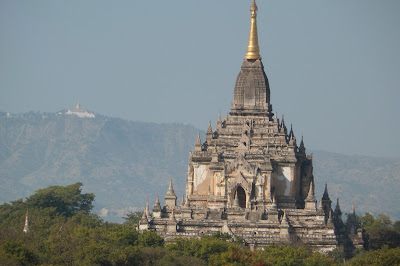The Bagan area was the center of the Kingdom of Pagan, the first politic entity to include the territory
of the modern Myanmar state. The area saw construction of over 2000 temples and stupas (structures that don't have an interior place for prayer), most of them in the eleventh through thirteenth centuries. According to Wikipedia the burden of tax-exempt religious property weakened the Pagan state to the extent that it fell to invaders in 1297. Keep in mind that these invaders were the Mongols, who ate the lunch of everyone in Asia and eastern Europe, so it might be unfair to blame Pagan's fall on excess temple property.
I think the temples are making up some of the damage, attracting tourists to the region. There are some luxurious hotels in the area. This one is owned by a relative of one of the junta that ruled Myanmar until a few years ago. For $300 US you can get up early and take a hot air balloon ride at dawn to view the temples. I chose to save my money, sleep in for a bit and take this picture from the terrace of our hotel.
 |
| We did more touristy type things in Bagan than during the rest of the tour. One afternoon we went on a short cruise on the Irawaddy River, the Road to Mandalay that connects the interior of Myanmar to the Andaman Sea. The short cruise concluded with a somewhat longer cocktail hour on the beach. This is the best sunset I saw in southeast Asia. |
 |
| The Shwezigon Pagoda is one of the oldest in the area. It's central bell-shaped stupa, shown above, is covered in gold leaf. It is the a major tourist attraction in the city of Nyaung-U, the capital of the modern district that includes Bagan. |
 |
Myanmar does not offer free public education. The temples offer some schooling for boys whose families are unable to pay. Myanmar boys are expected to spend some time in a monastery, wearing the robes and following the monastic routine. Most don't stay on for more than a few weeks. These boys are holding begging bowls. I had it explained to me that the monks do not beg; they merely make it possible for the pious laity to offer donations.
|





No comments:
Post a Comment